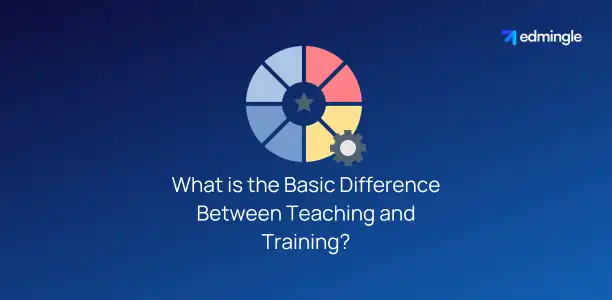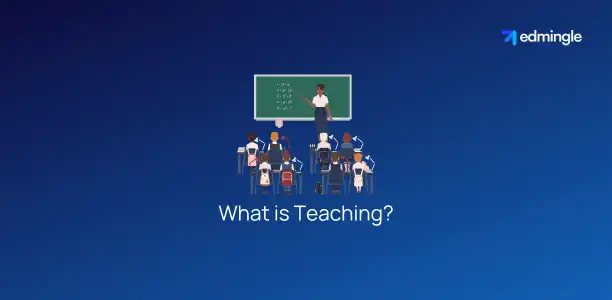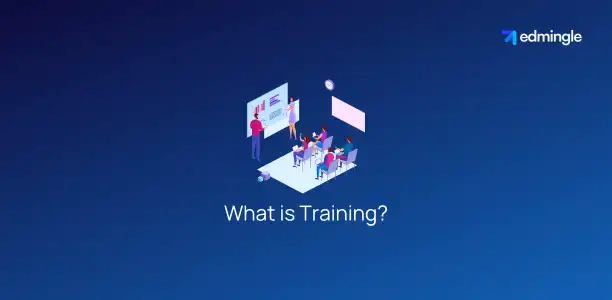
Today’s world is marked by continued education and professional development. And we’re talking about two commonly misinterpreted terms in this landscape.
The difference between teaching and training consists of a fine line. But what is it that draws this line? And above all, why is knowing this distinction important?
Recognizing the difference between teaching and training. Can lead to more effective educational strategies. And hence, better outcomes for learners.
In this blog, we aim to clarify these differences. Shedding light on how each method impacts learners and the learning environment. So let’s unravel.
What is the Basic Difference Between Teaching and Training?

Teaching is traditionally linked with imparting knowledge. It develops understanding and further fosters critical thinking. It’s about broadening the horizon of learners, often in academic settings.
The latter is more about skill acquisition and proficiency. It’s usually with a specific goal or task in mind. And often in a professional or vocational context.
Why is Understanding the Difference Between Teaching and Training Important?
It’s the age of personalization. And hence, generic solutions are generally cornered.
In such a scenario, understanding the difference between training and teaching becomes essential. Namely for the following reasons:
| 1.Targeted Approach for Desired Outcomes | Teaching and training have different objectives. Teaching typically aims to impart knowledge. The latter, on the other hand, focuses on skill development. Recognizing this difference allows educators & trainers to adopt the most effective methods. For achieving their specific educational or goals. |
| 2.Enhanced Learner Engagement | Different learners have different needs and respond better to different styles of instruction. By understanding which approach is more suitable. Instructors can tailor their methods to better engage learners. This tailored/personalized approach can lead to improved learner retention. Thereby, driving satisfaction and overall success. |
| 3.Effective Use of Time & Resources | Time is the most valuable commodity today. And knowing which method to employ. Can lead to more efficient use of time and resources. For instance. Training sessions in a corporate environment might require hands-on practice and scenario-based learning. Whereas an academic setting might benefit more from lectures, discussions, and theoretical exploration. Read our blog to know how Edmingle reduces your operational costs by 20%. |
| 4.Professional Skill Development | In the context of career development. Understanding this distinction helps professionals choose the right program or course to meet their career objectives. For example. People looking to enhance their theoretical knowledge in a field might seek out teaching-based courses. While someone looking to acquire a specific skill might look for training programs. Know about the difference between course and training. |
| 5.Adaptation to Learning Environments | Different environments call for different approaches. Educational institutions like schools and universities tend to focus more on teaching. While vocational schools and corporate programs might emphasize training. Understanding the difference helps in adapting to. Or creating the appropriate learning environment. |
| 6.Improved Communication and Expectation Setting | Clear understanding of these concepts allows educators, trainers & learners to communicate more effectively. Be it about their goals, expectations or the nature of the program they are engaged in. |
| 7.Supports Lifelong Learning | Recognizing this difference. Helps individuals understand that learning is not just confined to formal education. But extends to practical, hands-on training in various stages of their professional life. Read about the difference between learning and training. |
In short. A clear understanding of this difference is vital for effective education & skill development.
It ensures that the right methods are used in the right contexts. And for the benefit of both; learners and organizations.
What is Teaching?

Teaching is a process focused on imparting basic knowledge, concepts, and theories to learners.
It is often associated with academic settings. And aims to develop understanding, critical thinking, and intellectual growth.
Teaching goes beyond the mere presentation of facts. It involves guiding students to connect with and reflect upon the information presented.
Hence, encouraging a deeper comprehension of the subject matter.
Characteristics of Teaching
- Knowledge-Based: Emphasizes the delivery of theoretical and conceptual information.
- Long-Term Focus: Aims for the holistic development of the learner. Including cognitive and emotional growth over time.
- Interactive: Often involves two-way communication. Thereby, encouraging student participation, discussions, and feedback.
- Assessment-Oriented: Includes evaluating students through tests, exams, and assignments to measure understanding.
- Innovative and Adaptive: Teaching methods can vary widely. While adapting to the needs of students and the subject matter.
Types of Teaching
- Lecturing: Traditional method involving verbal instruction to a group of students.
- Collaborative Teaching: Involves group activities, discussions, cooperative & social learning strategies.
- Project-Based Learning: Students engage in complex, real-world projects over extended periods.
- Online and Blended Learning: Utilizes digital platforms for teaching. Either entirely online, blended learning or hybrid learning with common methods.
What is Training?

In contrast to teaching, it is a learning process designed to develop specific skills. Or competencies and behaviors.
Majorly, necessary for a particular job or activity. It is highly practical and performance-oriented.
And focuses on enabling individuals to perform specific tasks efficiently and effectively.
Characteristics of Training
- Skill-Focused: Centers around developing practical skills and abilities.
- Short-Term and Goal-Oriented: Often designed to achieve immediate objectives. Or to address specific workplace needs.
- Hands-On/Practical Approach: Involves practical exercises, simulations, and real-world applications.
- Performance Measurement: Here, success is measured by the ability to perform specific tasks or roles effectively.
- Customization: Training programs are often tailored to meet the specific needs of an organization. Or a particular job/profession role.
Types of Training
- On-the-Job Training: Employees learn in the actual work environment. By using the tools and equipment they will regularly use.
- Workshops and Seminars: Short, intensive programs focusing on specific skills or knowledge areas.
- E-Learning and Virtual: Digital platforms provide modules that can be accessed remotely.
- Mentorship and Coaching: One-on-one sessions to help an individual develop specific skills. Often under the guidance of a person with more experience.
In short, teaching fosters intellectual growth, while proper training is for practical application.
Both are crucial in different contexts. And serve different purposes in the spectrum of education and professional development.
Also Read: Difference Between Education and Training.
10 Key Differences Between Teaching and Training (Teaching vs Training)
The table below lists down the fundamental differences between teaching and training.
| Aspect | Teaching | Training |
|---|---|---|
| Focus | Theoretical knowledge and concepts. | Practical skills and specific task performance. |
| Objective | Intellectual development and critical thinking. | Skill acquisition and application in a specific area. |
| Duration | Long-term. With a focus on gradual understanding. | Short-term. Often with immediate application. |
| Methodology | Interactive methods, lectures, discussions. | Hands-on, practical exercises, simulations. |
| Classroom Environment | Educational institutions like schools and universities. | Workplaces, vocational centers. |
| Assessment | Tests, exams, and assignments to gauge understanding. | Performance evaluation based on task execution. |
| Customization | Less frequent, usually follows a set curriculum. | Highly tailored to specific job/profession roles or tasks. |
| Outcome Measure | Knowledge retention, understanding. | Competency in performing specific tasks. |
| Learner Role | Passive absorption and active engagement in learning. | Active participation in skill development by trainees. |
| Instructor Role | Guide, mentor, facilitator of knowledge. | Coach, mentor, facilitator of skills. |
Summary on Teaching vs Training
As we conclude our exploration into the world of teaching and training. It’s evident that both share the common goal of facilitating growth and development.
And, they do so in fundamentally different ways. Both are essential components of L&D.
They complement each other. Yet stand distinct in their purposes and methodologies. Understanding the major difference between teaching and training is a practical guide.
One that will help you create & choose the right path. For the right educational and professional endeavors.
FAQs on Difference Between Training and Teaching
1.Can someone be both a teacher and a trainer?
Absolutely, many professionals are both teachers and trainers. But they switch their approach based on the context. For instance, a university professor may teach theoretical concepts in the classroom. And also conduct workshops on practical knowledge applications.
2.Is training more important than teaching in a professional setting?
It totally depends on the context. In professional settings, the former is often more immediately relevant. However, teaching is crucial for long-term professional growth and adaptability.
3.Is online learning considered teaching or training?
Online learning can encompass both teaching and training. The classification depends on the content and objectives of the online course. If it’s focused on imparting theoretical knowledge, it’s teaching. And if it’s skill-based and practical, it’s training.
4.How does the role of a learner differ in teaching and training?
In teaching, learners are often more passive. They’re absorbing information and then applying it through critical thinking. While in training, trainees are usually more active. They directly practice and apply the skills being taught.
5.Can training be effective without a foundation of teaching?
While training can be effective on its own for specific skill development. A foundational understanding gained through teaching. Can enhance a learner’s ability to grasp complex skills. And furthermore, to adapt them in different contexts.






Leave a Reply